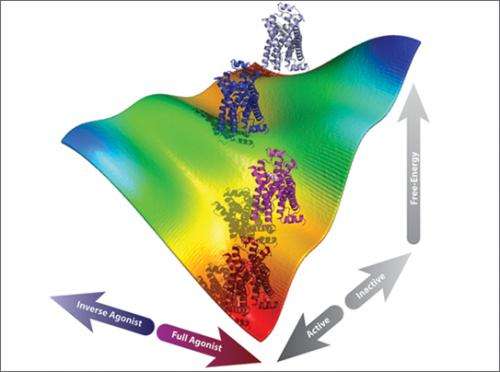TACC supercomputers simulate organization of membrane proteins at cell surface

The last time you popped a pill for a headache or a stuffy nose, did you think about how the medication actually alleviates your pain or unblocks your stuffy nose? Curing a disease is a complex process and involves understanding how various proteins found on the surface of human body cells convert external stimuli into intracellular biological signals.
Cell signaling intrigues Dr. Marta Filizola, an associate professor of Structural and Chemical Biology at Mount Sinai School of Medicine in New York. Her laboratory work is focused on understanding signal transduction processes mediated by certain cell surface membrane proteins called G protein-coupled receptors, which interact with about half of all drugs currently on the market. Important insights into how these proteins work at a molecular level earned the scientists who contributed to them the Nobel Prize in Chemistry in 2012.
"Membrane proteins are protein molecules embedded in the cell membrane surface," Filizola says. "They play a major role in mediating the effect of drugs."
G protein-coupled receptors are important molecular machines since they respond to a variety of stimuli, including the chemicals in a drug. "They interact with various agents, change form, and translate the information about these chemicals into a biological signal in the interior of the cell," Filizola says. By doing this they help the drug exert its function on disease states.
Without G protein-coupled receptors, medicines would not be effective because they would not know their way into the cell. Yet the exact workings of the G protein-coupled receptors at the molecular level are still shrouded in mystery. There is a huge amount of debate as to what exact parts of these proteins are important and how other aspects, like their ability to assemble (or oligomerize) in the cell surface membrane, affect cell signaling.
The Filizola lab runs computer simulations of oligomeric assemblies of G protein-coupled receptors on the supercomputers at the Texas Advanced Computing Center (TACC), trying to answer questions like: How do drugs affect the spatio-temporal organization of G protein-coupled receptors in the cell membrane?
.jpg)
"G protein-coupled receptors have been reported to form oligomeric complexes in a variety of disease states," she says. "I'm trying to find out how these protein complexes process cell signaling so that we can make drugs more specific and design more efficient medicines."
Understanding how opioid receptors work is an important aspect of research in the Filizola lab. Opioid receptors are a group of G protein-coupled receptors that respond to opioids (medications commonly used to relieve pain). Their latest simulations are aimed at comprehending the fundamental mechanisms of the opioid receptor function. The Filizola lab creates movies from the simulations that reveal the way proteins (which are never static) interact with drug molecules and other proteins. These 'movies' help identify the factors that contribute to a molecular-level understanding of the mechanism of action of drugs at individual or oligomeric receptors. This information is used to create more efficient medications or to stop unpleasant side effects.
In a recently published paper in PLoS Computational Biology, the Filizola lab examined how different drugs can change the shape of a prototypic G protein-coupled receptor, thus producing different biological responses. In another paper, also in PLoS Computational Biology2, they present a methodology to estimate how strong interactions between G protein-coupled receptors can be.
"Interactions between receptors can be quite dynamic in nature," Filizola says. Understanding how drugs bind to a G protein-coupled receptor and the changes this binding induce to the receptor may help researchers discriminate those causative elements that stimulate the side effects.
She is hoping that the results of her simulations will help formulate new hypotheses on how drugs and protein receptors function so one can work on creating effective drugs with minimal side effects.
"Side effects are an important issue," Filizola says. "We can develop the best pain curing medication ever, but if it causes an addiction then how good is it really?"
The technical issues involved in this kind of research are tough. She uses the Ranger supercomputer extensively in her work, in addition to the Scientific Computing Facility at Mount Sinai, but points out the limitations of simulations.
"We have to observe the movements of the proteins for a long time," she says. "Models here are only approximations and the simulations involved are complex. It's easy to miss out on important aspects of the interactions even though now we have access to more detailed structural information about G protein-coupled receptors and resources like those of TACC to help the computations necessary. These aren't simulations you can run on your desktop."
In the future Filizola plans to extend her molecular dynamics simulations to even larger supramolecular complexes to understand cell signaling better.
"Safer and effective drugs are a pressing need and we must address the complexities involved fast."
Provided by University of Texas at Austin

















